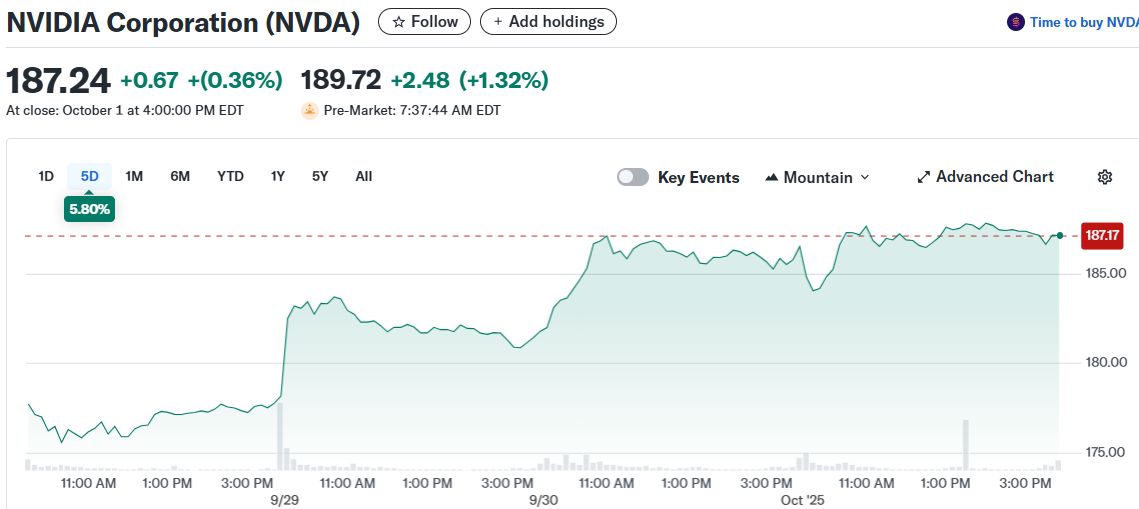TLDR
- Nvidia announced a strategic partnership to invest up to $100 billion in OpenAI, with the deal supporting new data centers requiring at least 10 gigawatts of power
- The computing capacity could cost nearly $600 billion total, with approximately $350 billion potentially going to Nvidia for its advanced AI chips
- Veteran tech investor James Anderson, early backer of Tesla and Amazon, expressed concern that the deal structure resembles vendor financing practices from the dot-com bubble
- OpenAI’s valuation reportedly jumped to $500 billion from $300 billion in April, while Anthropic’s valuation nearly tripled from $60 billion to $170 billion
- Anderson described the rapid AI valuation increases as “disconcerting” and said Nvidia’s move gives him more reasons to worry about the company than ever before
Last Monday, Nvidia and OpenAI unveiled a partnership that has the tech world buzzing for all the wrong reasons. The deal calls for Nvidia to invest as much as $100 billion in the AI startup.

The investment will fund new data centers with a minimum capacity of 10 gigawatts of power. According to the Financial Times, the total computing capacity could run close to $600 billion.
Of that massive sum, roughly $350 billion could flow directly to Nvidia for its advanced chips. These chips power the training and deployment of AI models.
Nvidia shares rose nearly 4% after news of the deal broke. The company now holds a market value exceeding $4.5 trillion, making it the world’s largest.
OpenAI carries a valuation near $500 billion, making it the most valuable private company. ChatGPT claims more than 700 million monthly users, though the company’s path to profit remains murky.
Dot-Com Déjà Vu
James Anderson isn’t buying the hype. The British investor, who made early bets on Tesla, Amazon, and Tencent, sees troubling parallels to the early 2000s.
Anderson now serves as managing partner at Italian investment firm Lingotto. He said the Nvidia-OpenAI structure reminded him of vendor financing from the telecom bubble.
Under the deal, OpenAI pays Nvidia cash for chips. Nvidia then invests that money back into OpenAI for non-controlling shares.
“I have to say the words ‘vendor financing’ do not carry nice reflections to somebody of my age,” Anderson told the Financial Times. “It’s not quite like what many of the telecom suppliers were up to in 1999-2000 but it has certain rhymes to it.”
Anderson said the deal gave him more reasons to worry about Nvidia than at any point before. He described the practice as uncomfortable from an investment perspective.
Nvidia has made smaller AI investments before now. The company recently put $5 billion into Intel and holds a 7% stake in cloud-computing firm CoreWeave.
It also backs Elon Musk’s xAI venture. But the OpenAI deal dwarfs these previous commitments.
Valuation Concerns Mount
Anderson pointed to rapid valuation increases across AI companies as a warning sign. OpenAI’s reported valuation jumped from $300 billion in April to $500 billion now.
Rival Anthropic saw its value nearly triple from $60 billion in March to $170 billion last month. Nvidia briefly touched a $4.5 trillion market cap earlier this week.
“That scale of jump and the pace with which it happened did bother me,” Anderson said. He called the sudden increases “disconcerting.”
Until recently, Anderson hadn’t seen clear bubble signs in AI investing. The speed of recent valuation changes altered his view.
Other mega-cap companies have made similar moves. Microsoft ranks as one of OpenAI’s biggest stakeholders, while Amazon invested heavily in Anthropic.
Critics have compared the circular investment structure to practices that fueled the dot-com crash. Some analysts worry these deals mainly serve to boost demand for Nvidia’s chips.
Defenders argue today’s AI leaders differ from 1990s startups. Companies like Microsoft and Amazon are profitable, cash-rich giants with hundreds of billions to spend.
For these firms, the risk of underinvesting may exceed the danger of overspending. AI could drive enormous productivity gains across industries.
Some companies already show positive AI impacts on their businesses. The AI trade has broadened beyond the “Mag 7” tech stocks recently.
Palantir and Oracle have posted strong performances in recent weeks. On TipRanks, Nvidia maintains a Strong Buy rating based on 36 Buy, 2 Hold, and 1 Sell recommendations.
The consensus price target sits at $213.35, implying a 14.35% upside from current levels. The highest analyst price target reaches $250.
Stay Ahead of the Market with Benzinga Pro!
Want to trade like a pro? Benzinga Pro gives you the edge you need in today's fast-paced markets. Get real-time news, exclusive insights, and powerful tools trusted by professional traders:
- Breaking market-moving stories before they hit mainstream media
- Live audio squawk for hands-free market updates
- Advanced stock scanner to spot promising trades
- Expert trade ideas and on-demand support



